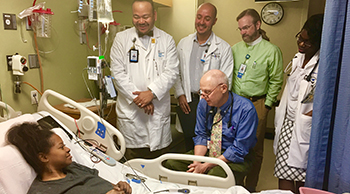-
Services
Featured Specialties
-
Locations
Location Type
-
Patients & Visitors

Every day, a multidisciplinary team rounds on patients in YNHH’s Sickle Cell/General Medicine unit. During recent rounds, John Roberts, MD, talked with patient Sarla Chastine. Other team members included (l-r): Jack Gorero, RN; Frank Zamora, PharmD, clinical pharmacist; Randall Spaulding, chaplain; and Sandie Jean, APRN.
In his office on EP 6-7, Jack Gorero, RN, has a photo of a 2012 ribbon-cutting that officially dedicated the new Sickle Cell/General Medicine unit. One of the ribbon-cutters is a patient clad in a hospital gown.
“He used to spend 200 out of 365 days a year in the hospital. Now we hardly see him,” said Gorero, patient service manager. “He is able to manage his pain at home, he has a job and is living his life.”
This is the kind of outcome Gorero and John Roberts, MD, medical director, Adult Sickle Cell Program, had hoped for when they began transforming the way Yale New Haven Hospital cares for adults with sickle cell disease five years ago. A hereditary blood disease, sickle cell can cause daily pain punctuated by episodes of severe pain. It is difficult for patients and medical professionals to manage, in part because opioid medications are necessary and patients must be closely monitored, Dr. Roberts said.
Previously, patients experiencing severe pain crises would go to the Emergency Department and be admitted to various inpatient units throughout the hospital. From visit to visit, patients were cared for by different providers, most of whom did not specialize in treating and managing sickle cell disease. “Sickle cell treatment must be consistent along the entire continuum of care, from inpatient to outpatient to community settings,” Dr. Roberts said.
YNHH's treatment approach includes:
Thanks to these and other measures, from 2013 to 2017, the inpatient unit’s average length of stay dropped by 60 percent, outpatient visits increased 96 percent and ED visits dropped 46 percent. Most importantly, a majority of patients are satisfied with the consistent care and support.
“Our goal is to empower our patients, to get them involved in their care,” Gorero said. “We help them get their lives back.”